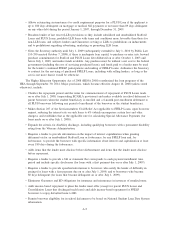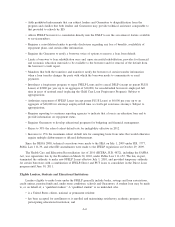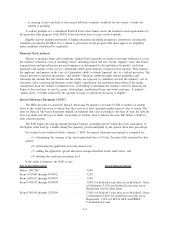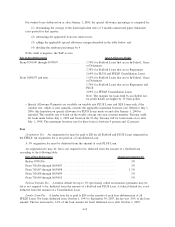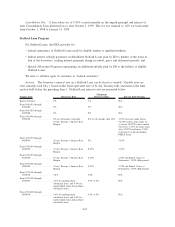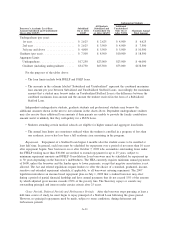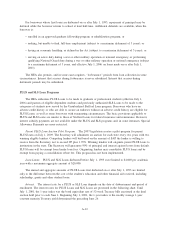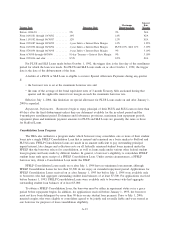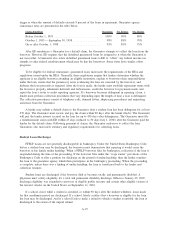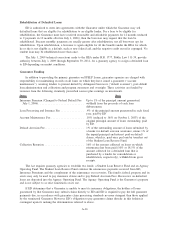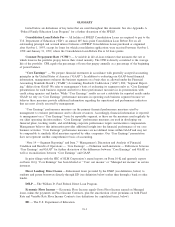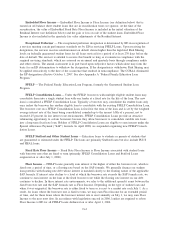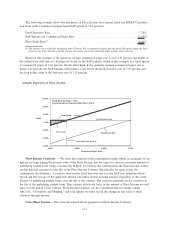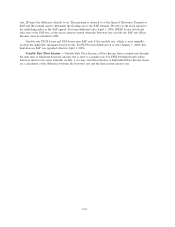Sallie Mae 2010 Annual Report Download - page 220
Download and view the complete annual report
Please find page 220 of the 2010 Sallie Mae annual report below. You can navigate through the pages in the report by either clicking on the pages listed below, or by using the keyword search tool below to find specific information within the annual report.
trigger is when the amount of defaults exceeds 9 percent of the loans in repayment. Guarantee agency
reinsurance rates are presented in the table below.
Claims Paid Date Maximum 5% Trigger 9% Trigger
Before October 1, 1993 ............................. 100% 90% 80%
October 1, 1993 — September 30, 1998 ................. 98% 88% 78%
On or after October 1, 1998 .......................... 95% 85% 75%
After ED reimburses a Guarantor for a default claim, the Guarantor attempts to collect the loan from the
borrower. However, ED requires that the defaulted guaranteed loans be assigned to it when the Guarantor is
not successful. A Guarantor also refers defaulted guaranteed loans to ED to “offset” any federal income tax
refunds or other federal reimbursement which may be due the borrowers. Some states have similar offset
programs.
To be eligible for federal reinsurance, guaranteed loans must meet the requirements of the HEA and
regulations issued under the HEA. Generally, these regulations require that lenders determine whether the
applicant is an eligible borrower attending an eligible institution, explain to borrowers their responsibilities
under the loan, ensure that the promissory notes evidencing the loan are executed by the borrower; and
disburse the loan proceeds as required. After the loan is made, the lender must establish repayment terms with
the borrower, properly administer deferrals and forbearances, credit the borrower for payments made, and
report the loan’s status to credit reporting agencies. If a borrower becomes delinquent in repaying a loan, a
lender must perform collection procedures that vary depending upon the length of time a loan is delinquent.
The collection procedures consist of telephone calls, demand letters, skiptracing procedures and requesting
assistance from the Guarantor.
A lender may submit a default claim to the Guarantor after a student loan has been delinquent for at least
270 days. The Guarantor must review and pay the claim within 90 days after the lender filed it. The Guarantor
will pay the lender interest accrued on the loan for up to 450 days after delinquency. The Guarantor must file
a reimbursement claim with ED within 45 days (reduced to 30 days July 1, 2006) after the Guarantor paid the
lender for the default claim. Following payment of claims, the Guarantor endeavors to collect the loan.
Guarantors also must meet statutory and regulatory requirements for collecting loans.
Student Loan Discharges
FFELP Loans are not generally dischargeable in bankruptcy. Under the United States Bankruptcy Code,
before a student loan may be discharged, the borrower must demonstrate that repaying it would cause the
borrower or his family undue hardship. When a FFELP borrower files for bankruptcy, collection of the loan is
suspended during the time of the proceeding. If the borrower files under the “wage earner” provisions of the
Bankruptcy Code or files a petition for discharge on the ground of undue hardship, then the lender transfers
the loan to the guarantee agency which then participates in the bankruptcy proceeding. When the proceeding
is complete, unless there was a finding of undue hardship, the loan is transferred back to the lender and
collection resumes.
Student loans are discharged if the borrower died or becomes totally and permanently disabled. A
physician must certify eligibility for a total and permanent disability discharge. Effective January 29, 2007,
discharge eligibility was extended to survivors of eligible public servants and certain other eligible victims of
the terrorist attacks on the United States on September 11, 2001.
If a school closes while a student is enrolled, or within 90 days after the student withdrew, loans made
for that enrollment period are discharged. If a school falsely certifies that a borrower is eligible for the loan,
the loan may be discharged. And if a school fails to make a refund to which a student is entitled, the loan is
discharged to the extent of the unpaid refund.
A-15


